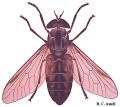Managing Flies Around Horses and Barns
by Robert N. Oglesby DVM
Introduction
Introduction
»
Life Cycle
»
Controlling Breeding
»
Repelling Flies
»
Killing Flies
»
Summary
»
More Info & Discussions
In the list of problems that horse owners report, flies rank near the top. Besides the common housefly which is such a nuisance around the barn and when trying to work on your horse, are the extremely painful biting stable flies, horseflies, deerflies, and midges of which there are dozens of different species. These flies attack our horses while in the field and while we ride and besides the very painful bite they are also responsible for a number of behavioral and disease problems. Because of the different life cycles and habits of these flies a number of different management procedures and strategies must exist to control this problem. This article deals with descriptions of the common flies that cause problems and strategies to fight back and provides an easy to use checklist for controlling flies around you and your horses.
A Generalized Fly Life Cycle But With Important Differences
Introduction
»
Life Cycle
»
Controlling Breeding
»
Repelling Flies
»
Killing Flies
»
Summary
»
More Info & Discussions

|
 Stableflies look just like houseflies except for the sticking mouth part with which they can cause a very painful bite.
Stableflies look just like houseflies except for the sticking mouth part with which they can cause a very painful bite.
|
 With the swept back wings deeflies are easily identified.
With the swept back wings deeflies are easily identified.
|
 Very variable in size from a large housefly to the size of small helicopters.
Very variable in size from a large housefly to the size of small helicopters.
|
No matter which of the dozens of fly species you are talking about there is a similar life: egg, larva, pupa and adult. However there are important variations in how each specie completes this life cycle. Some of the important species to horse owners have the following cycles:
- In the case of houseflies, face flies and the similar looking biting stable flies, the pupa are maggots feeding off decaying vegetable or animal material.
- In the case of horseflies and deerflies, a aquatic predatory larvae that feeds on other insect larvae occurs. These larvae can live in either still or running water. Also important is too know these are strong fliers and can travel quite a distance.
- Midges also have a aquatic larval stage but unlike their larger cousins they prefer still water or even very damp places for breeding. Midges are weak fliers and therefore do not travel far unless the winds sweep them.
It is possible to design strategies that attack these pests at several of these stages and successful control will depends this. By identifying the specific fly problem you have and understanding the life cycle you can better target your enemy.
Controlling the Breeding Sites
Introduction
»
Life Cycle
»
Controlling Breeding
»
Repelling Flies
»
Killing Flies
»
Summary
»
More Info & Discussions
You have just read the beginning of this article. To access the unabridged article
become a Member of Horseadvice.com! Your membership gets you instant access to this and over 600 articles on our site. Other benefits of your membership include participation in our discussion boards and access to our one button PubMed search tool for each topic.
Horseadvice can teach you to be a more knowledgeable horse owner which leads to a healthier horse and save you money. Really, we guarantee it.
Come Join Us!

 Stableflies look just like houseflies except for the sticking mouth part with which they can cause a very painful bite.
Stableflies look just like houseflies except for the sticking mouth part with which they can cause a very painful bite. With the swept back wings deeflies are easily identified.
With the swept back wings deeflies are easily identified. Very variable in size from a large housefly to the size of small helicopters.
Very variable in size from a large housefly to the size of small helicopters.